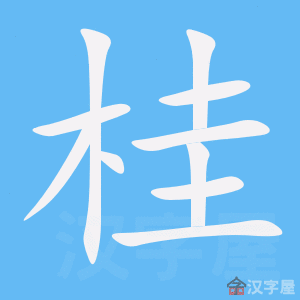Character
| HSK | Not in HSK |
|---|---|
| FREQUENCY | 1930th character |
| RADICAL | ⽊ (75.6) |
| STROKES | 10 |
| INDEX # | 1835 |
cassia or cinnamon
#1930
DEFINITIONS
- cassia or cinnamon
- surname Gui
- abbr. for Guangxi Autonomous Region 廣西壯族自治區|广西壮族自治区[Guang3 xi1 Zhuang4 zu2 Zi4 zhi4 qu1]
- cassia
- laurel
STROKES


WORDS
| 肉桂 ròu guì | Chinese cinnamon (Cinnamomum cassia) |
| 桂冠 guì guān | laurel; victory garland (in Greek and Western culture) |
| 桂皮 guì pí | Chinese cinnamon (Cinnamonum cassia); cassia bark |
| 折桂 zhé guì | to win the laurels; to pass an imperial examination; to win a championship |
| 桂林 guì lín | Guilin prefecture-level city in Guangxi |
| 桂格 guì gé | Quaker (company) |
| 桂花 guì huā | osmanthus flowers; Osmanthus fragrans |
| 丹桂 dān guì | orange osmanthus |
| 倪桂珍 ní guì zhēn | Ni Guizhen or Ni Kwei-Tseng (1869 - 1931), mother of Song Ailing 宋藹齡|宋蔼龄[Song4 Ai3 ling2], Song Qingling 宋慶齡|宋庆龄[Song4 Qing4 ling2] and Song Meiling 宋美齡|宋美龄[Song4 Mei3 ling2] |
| 吴三桂 wú sān guì | Wu Sangui (1612-1678), Chinese general who let the Manchus into China and helped them establish the Qing Dynasty, later leading a revolt against Qing in an effort to start his own dynasty |
| 吳三桂 wú sān guì | Wu Sangui (1612-1678), Chinese general who let the Manchus into China and helped them establish the Qing Dynasty, later leading a revolt against Qing in an effort to start his own dynasty |
| 官桂 guān guì | Chinese cinnamon (Cinnamomum cassia); also written 肉桂[rou4 gui4] |
| 月桂 yuè guì | laurel (Laurus nobilis); bay tree; bay leaf |
| 月桂冠 yuè guì guān | laurel crown; victory garland (in Greek and Western culture) |
| 月桂树 yuè guì shù | laurel tree (Laurus nobilis); bay tree |
| 月桂樹 yuè guì shù | laurel tree (Laurus nobilis); bay tree |
| 月桂树叶 yuè guì shù yè | laurel leaf; bay leaf |
| 月桂樹葉 yuè guì shù yè | laurel leaf; bay leaf |
| 月桂叶 yuè guì yè | bay leaf; laurel leaf |
| 月桂葉 yuè guì yè | bay leaf; laurel leaf |
| 李成桂 lǐ chéng guì | Yi Seong-gye (1335-1408), founder and first king of Korean Yi dynasty (1392-1910) |
| 桂北越城岭 guì běi yuè chéng lǐng | Mt Yuexiu, Guanxi |
| 桂北越城嶺 guì běi yuè chéng lǐng | Mt Yuexiu, Guanxi |
| 桂圆 guì yuán | see 龍眼|龙眼[long2 yan3] |
| 桂圓 guì yuán | see 龍眼|龙眼[long2 yan3] |
Previous
Next